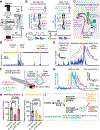Norepinephrine changes behavioral state through astroglial purinergic signaling
- PMID: 40373133
- PMCID: PMC12265949
- DOI: 10.1126/science.adq5233
Norepinephrine changes behavioral state through astroglial purinergic signaling
Abstract
Both neurons and glia communicate through diffusible neuromodulators; however, how neuron-glial interactions in such neuromodulatory networks influence circuit computation and behavior is unclear. During futility-induced behavioral transitions in the larval zebrafish, the neuromodulator norepinephrine (NE) drives fast excitation and delayed inhibition of behavior and circuit activity. We found that astroglial purinergic signaling implements the inhibitory arm of this motif. In larval zebrafish, NE triggers astroglial release of adenosine triphosphate (ATP), extracellular conversion of ATP into adenosine, and behavioral suppression through activation of hindbrain neuronal adenosine receptors. Our results suggest a computational and behavioral role for an evolutionarily conserved astroglial purinergic signaling axis in NE-mediated behavioral and brain state transitions and position astroglia as important effectors in neuromodulatory signaling.
Conflict of interest statement
Figures




Update of
-
Norepinephrine changes behavioral state via astroglial purinergic signaling.bioRxiv [Preprint]. 2024 May 23:2024.05.23.595576. doi: 10.1101/2024.05.23.595576. bioRxiv. 2024. Update in: Science. 2025 May 15;388(6748):769-775. doi: 10.1126/science.adq5233. PMID: 38826423 Free PMC article. Updated. Preprint.
References
-
- Bennett MV, Nakajima Y, Pappas GD, Physiology and ultrastructure of electrotonic junctions. I. Supramedullary neurons. J. Neurophysiol. 30, 161–179 (1967). - PubMed
-
- Marques JC, Li M, Schaak D, Robson DN, Li JM, Internal state dynamics shape brainwide activity and foraging behaviour. Nature 577, 239–243 (2020). - PubMed
MeSH terms
Substances
Grants and funding
LinkOut - more resources
Full Text Sources

